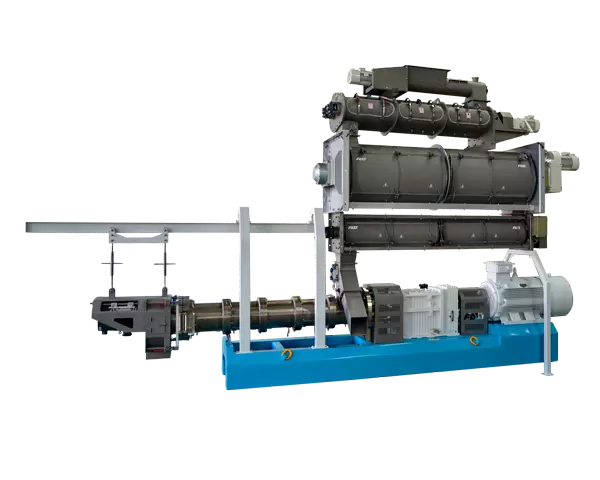In the modern feed processing industry, feed extruders are core equipment for achieving high-quality and efficient production. Whether used in fish feed extruders producing aquatic feed or animal feed extruders providing pelletized feed for livestock, stable discharge performance is a key factor in determining product consistency and process efficiency. However, in practice, many feed companies encounter problems such as uneven discharge, blockage, and large fluctuations in discharge performance. These issues not only affect product quality but can also lead to equipment wear and increased energy consumption.
This article systematically analyzes how to improve feed extruder discharge stability from five aspects: equipment structure, raw material control, process parameters, operating skills, and equipment selection. Drawing on the experience of leading domestic and international feed extruder manufacturers, this article proposes practical solutions to help you achieve efficient and stable extrusion production.
To improve discharge stability, it's important to first understand the common causes of unstable feed extruder discharge:
High fluctuations in raw material moisture content: The moisture content of raw materials directly affects the puffing effect during the extrusion process, which in turn affects the discharge quality.
Uneven material particle size: Particles that are too large or too small can affect the material's stress in the barrel, leading to an unstable discharge rhythm.
Screw wear or improper design: The screw is the core component for conveying and compressing the material. Wear or improper design can affect the consistency of the discharge.
Inaccurate temperature control: Thermal fluctuations during the extrusion process have a direct impact on the material's state. Excessively high or low temperatures can cause abnormal discharge.
Improper operating parameters: Improper settings such as feed rate, rotation speed, and heating temperature can cause fluctuating discharge.

Of all influencing factors, raw materials are fundamental. Whether using a fish feed extruder or an animal feed extruder, raw material handling must be carefully considered.
2.1 Controlling Moisture Content
The optimal moisture content range for different feeds varies. Generally speaking:
Fish feed extrusion: 16%-20%
Livestock feed extrusion: 14%-18%
Solutions:
Install a moisture meter for real-time pre-feed testing;
Equip moisture control equipment, such as a spray humidifier or drying system, to standardize the moisture content of the feed.
2.2 Maintaining Uniform Particle Size
A reasonable particle size improves material stress consistency. Recommendations:
Use a screen for secondary screening to remove overly coarse and fine particles;
Compare hammer mills and roller mills, selecting the appropriate crushing method based on product requirements.
3.1 Checking Screw and Sleeve Wear
The design of screw parameters such as pitch, helix angle, and compression ratio determines the pressure and propulsion rhythm of the material within the feed chamber. If the discharge rate slows or becomes uneven after a period of use, check for the following issues:
Screw wear, thinning, or defects;
Die hole clogging or scaling;
Residual material buildup on the inner wall of the sleeve. Solution:
Regularly replace or refurbish the screw;
Clean the die head and replace the mold when necessary;
Use an automatic lubrication and cleaning system to reduce manual maintenance.
3.2 Temperature Control System Optimization
Some feed extruder manufacturers have adopted PID intelligent temperature control systems, which enable multi-stage temperature control and real-time adjustment. It is recommended to select extrusion equipment with the following features:
Automatic alarm for abnormal temperature;
Multi-point temperature measurement and feedback control;
Preheating and overheating protection mechanisms.
Key process parameters that affect discharge stability include:
Feed speed: Too fast can easily cause material blockage; too slow can cause the screw to run idle and discontinuous discharge.
Screw speed: Determines the material shear rate and conveying speed and is generally controlled between 250 and 400 rpm.
Heating temperature: Common settings are 120°C to 160°C, with fine-tuning depending on the feed type.
Die pressure: Maintaining a certain pressure ensures full pellet formation and avoids underexpansion or breakage. Recommendation: Establish a database of optimal process parameters through experimentation, specifically tailoring them to specific product categories (floating fish feed, submerged feed, and poultry pellet feed).
Even with advanced equipment and qualified raw materials, inexperienced operators can lead to unstable feed output. Therefore, companies should strengthen operator training, including but not limited to:
Proper startup and shutdown procedures;
Troubleshooting common faults;
The ability to quickly respond to abnormalities;
Recording operating parameters and analyzing trends.
Many feed extruder manufacturers also offer operator training services. It is recommended to request equipment manuals and on-site technical guidance when purchasing.
Selecting feed extrusion equipment with stable performance and reliable quality is the fundamental guarantee for ensuring stable feed output. It is recommended to focus on the following aspects:
6.1 Selecting an Experienced Manufacturer
Prioritize feed extruder manufacturers with R&D capabilities, process innovation, and a strong after-sales service system. For example, manufacturers with automatic adjustment systems, variable frequency control technology, and remote monitoring capabilities should be considered. 6.2 Focus on Adaptability and Customization
For fish feed extruders, ensure they support dual-mode switching between floating and submerged feed.
For animal feed extruders, they should meet performance requirements such as high-pressure forming and uniform pellets.
Whether die heads and screws can be customized to meet different formulation requirements.
Provide adjustable production capacity options to meet the needs of different production scales.
Improving the output stability of a feed extruder is not a single task; it requires a multi-dimensional synergy of raw material preparation, equipment selection, process control, and personnel management. Whether it's a fish feed extruder in the aquaculture industry or an animal feed extruder in the livestock industry, both require a standardized, data-driven, and intelligent operating system based on actual production needs.
As a feed extruder manufacturer with many years of experience, we understand that the stable operation of each piece of equipment is driven by meticulous attention to detail and continuous investment in technological innovation. Only in this way can we help our customers achieve efficient, stable, and sustainable feed processing. To customize your own feed extrusion solution, please contact us for detailed information and technical support.